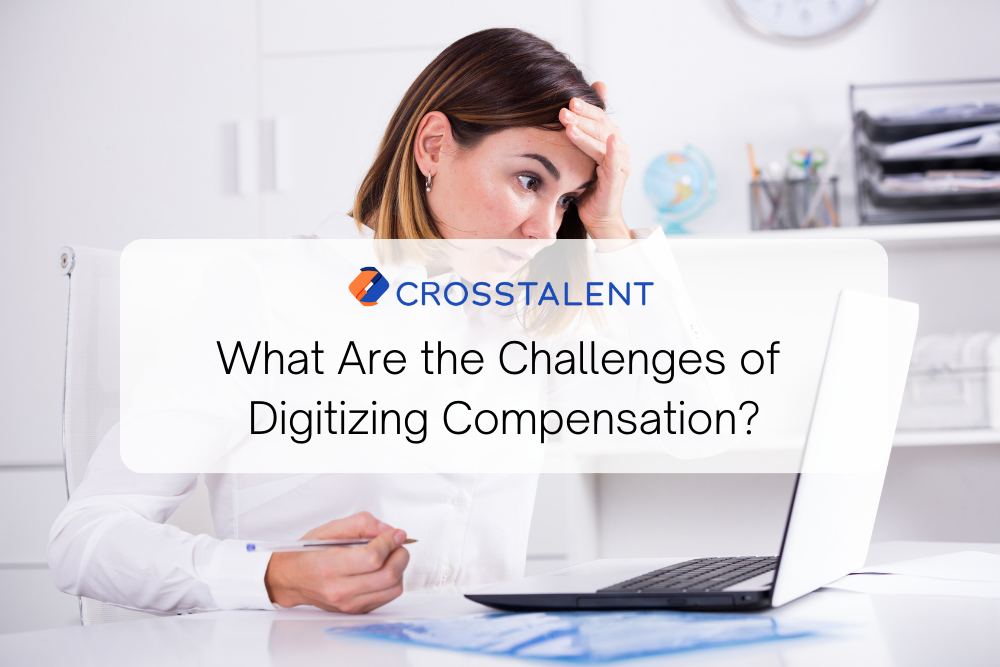The digitization of HR functions—and any company as a whole—is becoming one of the major challenges to overcome. While companies need to be at the cutting edge of innovation, there is one particularly sensitive and the focus of all attention: compensation.
As a catalyst for the company’s social climate, as well as its brand image, compensation cannot afford to suffer from any shortcomings. Can it be digitized? Will it be a source of interest for employers and employees alike? Are there any risks involved? We unpack it all.
Find out what’s at stake in digitizing employee compensation and what benefits you’ll gain.
What is Compensation?
Are salary compensation and compensation policies the same thing?
What are we talking about?
Intrinsically, salary compensation and salary policy refer to the same thing, i.e. the elements that make up employee remuneration. Whether this remuneration is entirely in cash, or a combination of cash and in-kind benefits. However, there are a few differences in the details.
Salary remuneration is made up of all the employee’s gross salaries at a given point in time. Remuneration policy, on the other hand, is made up of a set of rules that will determine future employee remuneration.
The remuneration policy may, for example, stipulate the percentage increases, both individual and collective, that may be granted during annual salary reviews, as well as the criteria on which employees will be eligible.
Why are salary reviews so important? As one of the primary sources of job satisfaction or, on the contrary, dissatisfaction, employee remuneration should never be neglected and/or forgotten. Companies wishing to retain and motivate not only their employees, but also and above all their talents, will need to carry out regular salary reviews.
However, these reviews should not be carried out haphazardly. After all, employees’ perception of salary reviews will have just as much influence on the final outcome as the review itself. As a result, an employee who feels “cheated out of a pay review” is likely to develop a sense of unease in the workplace, which could ultimately spread to the whole company.
In order to limit these impressions, it is essential to define a compensation and salary review policy that is precise and objective. In this area, the digitization of salary compensation is becoming a major ally that cannot be ignored.
The Main Challenges of Digitizing Compensation
Automate, Standardize and Secure Internal Processes
Made up of multiple elements, but also determined by a combination of different factors, remuneration is not always easy to assess. What’s more, the accompanying legal risk (inequality of treatment between men and women or between employees with the same qualifications, for example) is very real and can have major repercussions for the company.
In the vast majority of cases, managers use a set of four criteria to decide whether or not to give an employee a raise, and if so, by what percentage:
- Employee performance
- Competitive practices
- Employee potential
- Internal practices
While the internal and external benchmarking stages will have little influence on the affective and cognitive aspects of the human being, this is absolutely not the case when it comes to assessing employee performance and potential for development.
So, despite all his goodwill and integrity, a manager can be influenced positively or negatively by his effect on an employee. Whether the situation is real or not, whether a manager favors an employee with whom he or she gets on well or not, or, on the contrary, holds back the progress and raises of someone he or she doesn’t like, the risks incurred by the company are numerous.
Let’s not forget that while the internal data collection stages of compensation are unlikely to be impacted by the cognitive aspect of humans, this doesn’t mean they remain risk-free. Indeed, without the digitization of salary revaluation practices, the risks of errors during data collection are high, such as :
- Errors when selecting spreadsheet data
- Data entry errors, typos, or errors in line reporting
These are just some of the factors that can undermine the legitimacy of your decisions and actions.
By digitizing compensation and salary policy, HR departments, employers, and managers are freed from the limitations and weaknesses of traditional processes.
Uniformity of rules and procedures, enforceability, time-saving, reliability, KPIs and performance management indicators are just some of the advantages offered by the digitization of employee compensation.
Securing Personal Data and GDPR Compliance
Opting for the digitization of salary compensation also means ensuring the security of the data collected and, above all, compliance with this collection.
Between the obligations linked to the GDPR, but also the risks of discrimination or filing, the collection of personal data that can be used for compensation purposes is a balancing act.
Unlike in-house files, which are very often drawn up on Excel, equipping yourself with software dedicated to this task means you benefit from a framework and support in full compliance with French legislation.
As privacy and data security are also paramount, at Crosstalent we offer you the guarantee of European hosting providers and multiple automatic backups to limit the risk of data loss.
Reliable Data and Access to All Historical Data
As we’ve just seen, one of the other risks of not digitizing your payroll is the risk of making data entry errors when reprocessing or transcribing information.
With digitization, all these steps are automated, and the data sources are completely reliable, coming as they do from your payroll and/or HR software. At the click of a button, you can extract, cross-reference and analyze all the information you need.
It also gives you direct access to all employee salary revision histories. This will enable you to make arbitrations in the most optimal and equitable way possible.
Digitizing your compensation policy also means having access to a means of action and communication for building talent loyalty. This is made possible by the possibility of publishing an individual social balance sheet listing all the elements making up your employees’ remuneration for the year, such as :
- Benefits in kind: vehicle, packed lunches, luncheon vouchers, etc.
- Social benefits: health insurance, vacation vouchers, etc.
- Variable and exceptional bonuses, profit-sharing, etc.
- Generation of monitoring indicators and KPIs
Equipping yourself with a digital tool for monitoring and managing your employee compensation also means equipping yourself with a powerful technical tool that will help you in your day-to-day decision-making.
Financial tracking, setting up KPIs to measure performance, monitoring and measuring the rate of achievement of objectives, allocating time according to projects, missions, or any other indicator, etc. Thanks to our personalized Remuneration dashboard, you’ll be able to configure and customize your HRIS system to suit your needs and desires.
Involve All Players in the Salary Review Process
Involving all players in the salary review process has several positive impacts on the company. Firstly, managers, team leaders, and other N+1s are generally in the best position to determine the merit of employees and to validate whether or not objectives have been met.
These two pieces of information are indispensable when it comes to determining the amount of individual raises. But the benefits of their involvement don’t stop there.
Including them in this process is also a way of recognizing their work and their value to the company. This will inevitably contribute to their motivation at work, their performance, and the maintenance of a social climate that is conducive to productivity and calm.
Specify Rights, Access, and Authorizations According to Hierarchical Levels
The use of a tool dedicated to employee remuneration makes it possible to differentiate authorizations and action levels according to access profiles. It is then possible to define a global envelope, distribute it according to departments, and allow employees, N+1s and N+2s to make proposals for increases.
In this case, it is perfectly possible to let the employee estimate and justify the increase he or she deserves during an annual review. The employee’s N+1 can then confirm this proposal, or increase or even reduce it, depending on his or her analysis. In the final stage, the N+2 or the head of the HR department will have the opportunity to make the final decision and validate the increased envelope for each employee.
Remuneration Things to Remember
Much more secure and practical than Excel files, the digitization of salary remuneration brings reliability, security, speed, and ease of management to a company’s remuneration policy.
As with the introduction of any new process, it will be essential to support this change with employees, and to invest in an information and communication campaign. But once it has been accepted and integrated by all, the digitization of employee remuneration will simplify your day-to-day work while offering you reliability.
_____
Interested to learn more about Crosstalent’s Remuneration tools? Learn how to manage remuneration based on performance reviews, payment indicators, employee data, and more, from one HR tool. To visualize the process, speak to an expert. Request a demo today!



